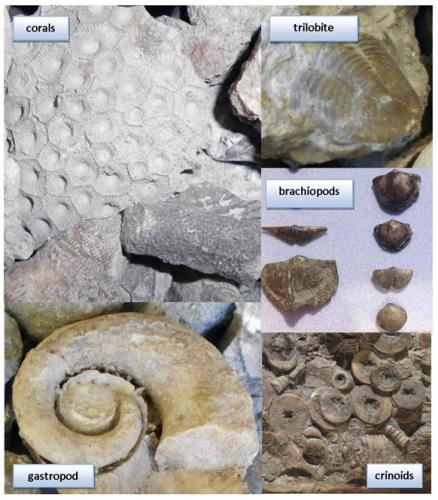Ancient fossils bring coastal tourism opportunities to life in Michigan
A visit to northeast Michigan’s coastline offers opportunities to explore life of the ancient oceans that existed more than 350 million years ago in the Great Lakes region.
Michigan is rich in Great Lakes and natural resources, but imagine if in trade these awesome freshwater lakes were instead saltwater oceans. Not too far from reality, Michigan, actually, once was a shallow saltwater sea – full of ocean life – that occurred hundreds of millions of years ago and long before glaciers carved the Great Lakes as we recognize them today!
A visit to coastal northeast Michigan offers an opportunity to find and explore, firsthand, fossils of these ancient Devonian Seas of the Great Lakes region. Corals and crinoids (sea lilies), sponges and  brachiopods (think sea shells), gastropods (snails) and trilobites – even an ancient fish – are all examples of living organisms that once thrived in these shallow ocean seas and now preserved in northeast Michigan rock formations.
brachiopods (think sea shells), gastropods (snails) and trilobites – even an ancient fish – are all examples of living organisms that once thrived in these shallow ocean seas and now preserved in northeast Michigan rock formations.
From rock quarries to fossilized ocean life and sinkholes to limestone cobble shorelines, this region’s unique geology is prized as a local coastal tourism asset and opportunity. Michigan Sea Grant and Michigan State University Extension have supported multiple sustainable coastal tourism research and development efforts with local partners and communities. These often identify opportunities to capitalize on these geological assets to promote sustainable coastal tourism across this region. These geology-based attractions are promoted by the U.S. 23 Huron Shores Heritage Route among a diversity of coastal tourism opportunities offered in the region; and the Besser Museum for Northeast Michigan offers a family Fall Harvest Fossil Fest celebrating how local geology has helped shape local communities and tourism in Northeast Michigan, scheduled this year for Saturday, October 5th from 12pm - 4pm in Alpena.
 Residents and visitors, alike, can explore the amazing geology of northeast Michigan’s coastline by way of rock hounding and fossil hunting throughout the region. Here are a few highlighted stops (and partners) to help get you started:
Residents and visitors, alike, can explore the amazing geology of northeast Michigan’s coastline by way of rock hounding and fossil hunting throughout the region. Here are a few highlighted stops (and partners) to help get you started:
- The Besser Museum, and the newly opened Lafarge Fossil Park, is a great place to add to your fossil collection AND to identify the fossils you may have discovered. Learn more about the region’s unique geology and fossils you’ll find thanks to some artistic interpretive signage created by youth the youth of Lincoln Elementary (Alpena Public School)– a place-based education project supported through the Northeast Michigan Great Lakes Stewardship Initiative network!
- Rockport State Recreation Area, managed by Michigan Department of Natural Resources, is a great stop for those seeking to find fossils, sinkholes, and some great nature-based hiking. Spend hours (and hours) in this abandoned limestone quarry finding nearly every type of Devonian Era fossil you might imagine. Large Petoskey stones (colonial coral fossils) are always a prized find in this quarry – and Rockport’s coastline is also known for amazing gastropod finds. The local Friends of Rockport often offer public events and activities for interested explorers.
- Exploring sinkholes sound fun to you? Consider a visit to the underwater sinkhole of El Cajun Bay (accessible from shore, by way of Alpena Township park property) or a more landside visit to the Stevens Twin Sinks managed by the Michigan Karst Conservancy.
- Rogers City offers an amazing quarry view of one of the world’s largest operating limestone quarries, owned by Carmeuse Lime & Stone; and be sure to visit the downtown community fossil park where you can hunt for ocean life fossilized in the stone excavated from this quarry.
- Downtown Alpena, walk the limestone boulders lining the shoreline of the Alpena Small Boat Harbor and Bay View or Mich-e-ke-wis Parks. Here you’ll find an amazing array of fossils including a wide diversity of brachiopods, and for lucky fossil hunters, maybe even an elusive trilobite.
- PaleoJoe, a Michigan business entrepreneur, shares his enthusiasm and expertise of local geology often offering ‘fossil digs’ along this northern Lake Huron coastline and partners with local libraries and the Besser Museum to offer educational seminars locally.
For more resources and information about Michigan geology and fossils, visit Michigan Department of Environmental Quality’s compilation of resources for students and teachers. Visiting coastal northeast Michigan? Plan your trip – visit the U.S. 23 Huron Shores Heritage Route website online: http://www.us23heritageroute.org/



 Print
Print Email
Email

